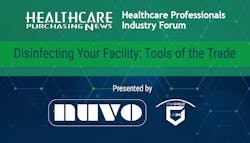How to effectively disinfect air in your healthcare facility
One of the Forum sessions featured Karen Hoffman, RN, MS, CIC, FAPIC, FSHEA, an infection preventionist consultant for the Vidashield UV24 from NUVO Surgical. She discussed the importance of air cleaning and disinfection in healthcare environments, regulations and standards for air quality, and the benefits of upper-room ultraviolet irradiation (UVGI) in healthcare and other settings.
Stopping airborne pathogen transmission
An aerosolized virus can travel through air before it lands on surfaces. SARS-CoV-2, the virus that causes COVID-19, is thought to spread mainly from person-to-person through respiratory droplets. The COVID-19 pandemic has been a wakeup call of the need to be more vigilant in prevention efforts of the invisible cloud of pathogenic agents in environments.
Each year, thousands of patients, healthcare workers and even visitors in healthcare facilities are colonized or sickened from airborne and contact transmission of infectious agents, including influenza, cold viruses, tuberculosis, and multiple antibiotic-resistant pathogens, like Methicillin-resistant Staphylococcus aureus (MRSA). Studies have found that in hospitals with air samples, on average, the air is two to eight times more contaminated than surfaces.
Air cleanliness is all about risk mitigation, and it is something healthcare facilities should constantly monitor and improve by implementing supplemental technologies as needed. The Centers for Disease Control and Prevention (CDC) has recommended adjuncts, like UVGI, to reduce viral particulates.
Meeting air quality standards
Healthcare facilities must follow federal regulatory agency requirements for air quality. These include the Centers for Medicare & Medicaid Services and the authorities having jurisdiction, who generally follow the American National Standards Institute’s American Society of Heating, Refrigerating and Air-Conditioning Engineers Standard 170-2017, Ventilation of Health Care Facilities. These standards have been adopted by the Federal Guidelines Institute for hospitals, outpatient facilities, and residential care facilities. Most facilities will follow CDC recommendations when applicable.
All of these regulatory authorities and associations recommend a layered approach to supplement areas where ventilation enhancement would mitigate risk of exposure, such as in emergency departments, intensive care units, break rooms, or patient care rooms with patients who are known or suspected to be infected with COVID-19. This care involves aerosolized-generating procedures, such as intubation and suctioning of the airway and nebulization of medications. Upper-air ultraviolet C (UVC) light systems may be recommended to be installed in communal spaces, such as in patient and waiting rooms, corridors, and break areas, to interrupt the transmission of airborne infectious agents.
Adding UVGI air disinfection
A variety of supplemental technologies can be an adjunct to clean air efforts, however, may be limiting, such as portable UVC light robots, which primarily are used for terminal cleaning, in-duct UVC systems, which primarily are used to disinfect biofilm buildup on the heating, ventilation, and air conditioning (HVAC) coils and ductwork, or portable high-efficiency particulate air (HEPA) systems, which are placed centrally in a room for disinfection.
Another supplemental solution is the Vidashield UV24 from NUVO Surgical. The Vidashield UV24 is an upper-air purification system that, because it is integrated into a ceiling light, will draw air up reducing the risk of cross transmission of bioaerosols. The system can be used with people present because the UV lamps are shielded, and the shields provide optimal air mixing. It runs continuously 24/7/365, which eliminates accidental turnoff or blocking of the directional flow.
The system treats the air to an additional four air exchanges per hour by first traveling past a MERV 6 filter to remove large particulates, and then neutralizing 97% of bioaerosols on the first pass by destroying the DNA or a bacteria’s ability to reproduce for a volume of air equivalent to an 8’ x 10’ x 10’ room. Results have included the elimination of many types of pathogens, including viruses, bacteria, molds, and allergens, and a significant decrease in surface contamination. The system is an engineering control, which is what the Occupational Safety and Health Administration recommends as the most important measure to use by eliminating the risk of cross contamination of microbial and other pathogens.
Forum available on-demand
Visit HPN at https://endeavor.swoogo.com/hpn_forum/about to register for the forum and watch the March sessions on-demand.
Also plan to view the next installment in the Healthcare Professionals Industry Forum series on May 12: “Lessons Learned in Surgical Services and Critical Care.”

